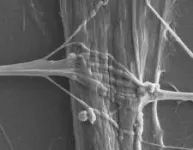(Press-News.org) BOSTON -- The foods people buy at a workplace cafeteria may not always be chosen to satisfy an individual craving or taste for a particular food. When co-workers are eating together, individuals are more likely to select foods that are as healthy--or unhealthy--as the food selections on their fellow employees' trays. "We found that individuals tend to mirror the food choices of others in their social circles, which may explain one way obesity spreads through social networks," says Douglas Levy, PhD, an investigator at the Mongan Institute Health Policy Research Center at Massachusetts General Hospital (MGH) and first author of new research published in Nature Human Behaviour. Levy and his co-investigators discovered that individuals' eating patterns can be shaped even by casual acquaintances, evidence that corroborates several multi-decade observational studies showing the influence of people's social ties on weight gain, alcohol consumption and eating behavior.
Previous research on social influence upon food choice had been primarily limited to highly controlled settings like studies of college students eating a single meal together, making it difficult to generalize findings to other age groups and to real-world environments. The study by Levy and his co-authors examined the cumulative social influence of food choices among approximately 6,000 MGH employees of diverse ages and socioeconomic status as they ate at the hospital system's seven cafeterias over two years. The healthfulness of employees' food purchases was determined using the hospital cafeterias' "traffic light" labeling system designating all food and beverages as green (healthy), yellow (less healthy) or red (unhealthy).
MGH employees may use their ID cards to pay at the hospitals' cafeterias, which allowed the researchers to collect data on individuals' specific food purchases, and when and where they purchased the food. The researchers inferred the participants' social networks by examining how many minutes apart two people made food purchases, how often those two people ate at the same time over many weeks, and whether two people visited a different cafeteria at the same time. "Two people who make purchases within two minutes of each other, for example, are more likely to know each other than those who make purchases 30 minutes apart," says Levy. And to validate the social network model, the researchers surveyed more than 1,000 employees, asking them to confirm the names of the people the investigators had identified as their dining partners.
"A novel aspect of our study was to combine complementary types of data and to borrow tools from social network analysis to examine how the eating behaviors of a large group of employees were socially connected over a long period of time," says co-author Mark Pachucki, PhD, associate professor of Sociology at the University of Massachusetts, Amherst.
Based on cross-sectional and longitudinal assessments of three million encounters between pairs of employees making cafeteria purchases together, the researchers found that food purchases by people who were connected to each other were consistently more alike than they were different. "The effect size was a bit stronger for healthy foods than for unhealthy foods," says Levy.
A key component of the research was to determine whether social networks truly influence eating behavior, or whether people with similar lifestyles and food preferences are more likely to become friends and eat together, a phenomenon known as homophily. "We controlled for characteristics that people had in common and analyzed the data from numerous perspectives, consistently finding results that supported social influence rather than homophily explanations," says Levy.
Why do people who are socially connected choose similar foods? Peer pressure is one explanation. "People may change their behavior to cement the relationship with someone in their social circle," says Levy. Co-workers may also implicitly or explicitly give each other license to choose unhealthy foods or exert pressure to make a healthier choice.
The study's findings have several broader implications for public health interventions to prevent obesity. One option may be to target pairs of people making food choices and offer two-for-one sales on salads and other healthful foods but no discounts on cheeseburgers. Another approach might be to have an influential person in a particular social circle model more healthful food choices, which will affect others in the network. The research also demonstrates to policymakers that an intervention that improves healthy eating in a particular group will also be of value to individuals socially connected to that group.
"As we emerge from the pandemic and transition back to in-person work, we have an opportunity to eat together in a more healthful way than we did before," says Pachucki. "If your eating habits shape how your co-workers eat--even just a little--then changing your food choices for the better might benefit your co-workers as well."
INFORMATION:
Levy is an associate professor of Medicine at Harvard Medical School (HMS). Pachucki is associate professor of Sociology at the UMass Computational Social Science Institute. A. James O'Malley, PhD, is professor of Biostatistics at the Dartmouth Institute and the Department of Biomedical Data Science at the Geisel School of Medicine at Dartmouth. Anne Thorndike, MD, MPH, is an investigator in the Division of General Internal Medicine at MGH and associate professor of Medicine at HMS.
Major funding was provided by the National Institute of Diabetes and Digestive and Kidney Diseases and the National Heart Lung and Blood Institute.
About the Massachusetts General Hospital
Massachusetts General Hospital, founded in 1811, is the original and largest teaching hospital of Harvard Medical School. END
A phase 1 clinical trial led by investigators at the University of Chicago Medicine testing the effects of stereotactic body radiotherapy for treating multiple metastases has determined that treatments used for single tumors can also be safely used for treating patients with multiple metastases. The study was run through NRG Oncology and sponsored by the National Cancer Institute. The results were published on April 22 in JAMA Oncology.
Cancer is traditionally treated with a combined approach, with clinicians using surgery, chemotherapy and radiation therapy to kill and remove cancerous tumors. Systemic ...
PHILADELPHIA--When researchers from Penn Medicine found that many patients with B-cell acute lymphoblastic leukemia (ALL) treated with the investigational chimeric antigen receptor (CAR) T cell therapy targeting the CD22 antigen didn't respond, they went back to the drawing board to determine why. They discovered that less is more when it comes to the length of what is known as the single-chain variable fragment -- the linker that bridges the two halves of the receptor that allows CAR T cells to latch onto tumor cells and attack them.
The findings are reported online today in Nature Medicine.
"A little difference of a few amino acids can make a huge difference for patients," said co-senior author Marco Ruella, MD, an ...
The 'stickiness', or viscosity, of microscopic liquids can now be measured thousands of times faster than ever before, potentially leading to better understanding of living cells, disease diagnostics and pharmaceutical testing.
University of Queensland's Professor Warwick Bowen and his colleagues at the Queensland Quantum Optics Lab developed the world-leading technology, technology that uses lasers to track microscale particles with world-record precision.
"The stickiness, or viscosity, of liquids is incredibly important in biology," Professor Bowen said.
"In living cells, viscosity fluctuations control shape and structure, modulate chemical reactions, and signal whether a cell is healthy or cancerous.
"However, ...
A new study has highlighted that while much is known about the ever increasing uptake of antidepressant medications around the world, there is very little evidence on safe and effective approaches to discontinuing treatment.
In 2020 there were 78 million prescriptions for antidepressants in England and about half of patients treated have taken them for at least two years. Guidelines typically recommend that antidepressants be taken for up to 6 to 12 months after improvement, or for up to two years in people at risk of relapse, but many people take antidepressants for much longer. Surveys of antidepressant users suggest that up to a half of people on long-term antidepressant prescriptions have no clear medical ...
Skeletal muscles enable voluntary movements and are controlled by a special type of neurons called motor neurons, which make direct contact with skeletal muscles through so-called neuromuscular junctions (NMJs). It is through NMJs that skeletal muscles receive signals making them contract or relax. In certain neurodegenerative diseases, such as amyotrophic lateral sclerosis (ALS), NMJs are destroyed, leading to progressive muscle weakness and ultimately death. Treatments for ALS mainly focus on alleviating symptoms but cannot stop or reverse its disease progression. To find more effective treatments, researchers require accurate and easily accessible lab-based models for ALS to understand its causes and to develop and test new therapies. One step in this ...
Transient grating spectroscopy is an elegant method that uses two laser pulses to activate a medium by creating an interference pattern made of parallel stripes of excitations that can be thermal, electronic, magnetic or even structural. The modulation depth of the pattern and its evolution can be measured by diffracting a third, time-delayed probe beam on the transient grating.
The modulation depth decays as the initial excitation propagates through the material. The distance between the stripes is determined by the wavelength of the pulses used to create the grating, which ...
Researchers at the Paul Scherrer Institute PSI have succeeded for the first time in looking inside materials using the method of transient grating spectroscopy with ultrafast X-rays at SwissFEL. The experiment at PSI is a milestone in observing processes in the world of atoms. The researchers are publishing their research results today in the journal Nature Photonics.
The structures on microchips are becoming ever tinier; hard disks write entire encyclopedias on magnetic disks the size of a fingernail. Many technologies are currently breaking through the boundaries of ...
States with stricter firearms laws reported lower suicide and homicide rates, according to a Rutgers study.
The study, conducted by the New Jersey Gun Violence Research Center, the Rutgers School of Public Health, the Rutgers University-Newark Department of Psychology, the Rutgers School of Criminal Justice, the Rutgers New Jersey Medical School and the Rutgers-Newark Department of Social Work, was published in the Journal of Public Health and examined the association between firearm laws and suicide and homicide rates.
Firearm violence is a major public health concern in the United States, with firearm suicide ...
Irvine, Calif., April 22, 2021 -- California's wildfire problem, fueled by a concurrence of climate change and a heightened risk of human-caused ignitions in once uninhabited areas, has been getting worse with each passing year of the 21st century.
Researchers in the Department of Civil & Environmental Engineering at the University of California, Irvine have conducted a thorough analysis of California Department of Forestry and Fire Protection wildfire statistics from 2000 to 2019, comparing them with data from 1920 to 1999. They learned that the annual burn season has lengthened in the past two decades and that the yearly peak has shifted from August to July. The team's findings are the subject of a study published today in the ...
A minimally invasive retinal reattachment procedure that can be done in an ophthalmologist's office leads to better long-term integrity and structure of the retina's photoreceptors - cells that allow us to see - compared with more invasive operating room procedures, according to new research published April 22.
The study, published in JAMA Ophthalmology and led by researchers at St. Michael's Hospital of Unity Health Toronto, contributes to a growing body of evidence pointing towards pneumatic retinopexy (PnR) as the better first-line retinal reattachment technique to achieve the best visual outcomes.
Retinal detachment is the most common surgical ocular emergency, progressing to loss of vision within hours ...




